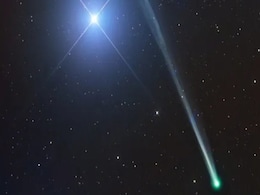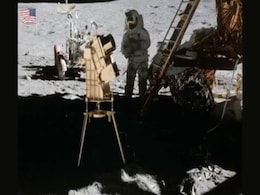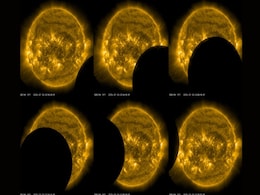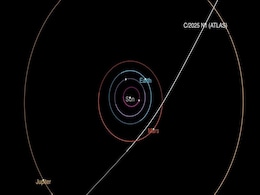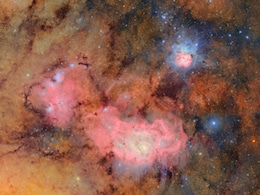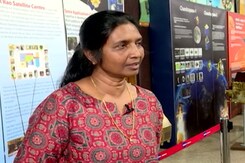Solar Observatory
- All
- News
- Videos
-

Neutrino Detectors May Unlock the Search for Light Dark Matter, Physicists Say
- Thursday December 11, 2025
- Written by Gadgets 360 Staff
Physicists now believe that massive neutrino detectors—built to observe rare solar and cosmic particles—could also detect extremely light dark matter that traditional experiments miss. By monitoring subtle annual variations in their background signals, observatories like JUNO and Borexino may open a new frontier in uncovering the universe’s m...
-
 www.gadgets360.com
www.gadgets360.com
-

India's Aditya-L1 Joins Global Effort To Study Solar Storm: ISRO
- Tuesday December 9, 2025
- India News | Press Trust of India
India's first solar observatory Aditya-L1 played a key role in helping scientists decode why the strongest solar storm in more than two decades that struck Earth in May 2024 behaved so unusually, ISRO said on Tuesday.
-
 www.ndtv.com
www.ndtv.com
-

With The Sun Nearing Its Peak, Aditya-L1 Prepares For Fierce Coronal Mass Ejections
- Monday December 1, 2025
- Science | Edited by Astitva Raj
Although CMEs do not directly harm humans, their impact on technological infrastructure can be severe.
-
 www.ndtv.com
www.ndtv.com
-

China’s Massive JUNO Experiment Delivers Its First World-Class Neutrino Results
- Friday November 28, 2025
- Written by Gadgets 360 Staff
China’s Jiangmen Underground Neutrino Observatory has delivered world-class results after only 59 days of data collection, achieving the most precise measurements yet of two major neutrino oscillation parameters. JUNO’s early performance surpasses all previous experiments, confirming a small but intriguing discrepancy between solar and reactor ...
-
 www.gadgets360.com
www.gadgets360.com
-

Astronomers Record First-Ever Massive Stellar Blast Capable Of Stripping Planetary Atmospheres
- Saturday November 22, 2025
- Science | Edited by Astitva Raj
This event originated from a red dwarf star, which is much dimmer, cooler, and smaller than the Sun.
-
 www.ndtv.com
www.ndtv.com
-

Mystery Deepens as Interstellar Comet 3I/ATLAS Brightens Unexpectedly Near the Sun
- Thursday November 6, 2025
- Written by Gadgets 360 Staff
Interstellar comet 3I/ATLAS defied expectations during its 2025 solar flyby, brightening far faster than predicted. Observatories worldwide recorded a blue coma rich in exotic gases, suggesting unique chemistry from another star system. Scientists are investigating whether its unusual composition or speed caused the outburst, marking a new interste...
-
 www.gadgets360.com
www.gadgets360.com
-

New Images of Interstellar Object 3I/ATLAS Show a Giant Jet Shooting Toward the Sun
- Sunday October 26, 2025
- Written by Gadgets 360 Staff
New telescope images show interstellar comet 3I/ATLAS ejecting a giant jet of gas and dust toward the Sun. Scientists say the phenomenon confirms its natural cometary behaviour, offering clues about how such ancient interstellar visitors react to solar heat.
-
 www.gadgets360.com
www.gadgets360.com
-

NASA Confirms Brightening Comet SWAN Could Be Visible With Binoculars: When and Where to See It
- Monday October 20, 2025
- Written by Gadgets 360 Staff
Comet SWAN (C/2025 R2), discovered via NASA’s SOHO spacecraft, is rapidly brightening as it nears its October 20–21 Earth flyby. Skywatchers should look to the western horizon after sunset to spot its vivid green coma and tail — possibly visible to the naked eye in dark conditions.
-
 www.gadgets360.com
www.gadgets360.com
-

NASA Prepares 2025 Carruthers Mission to Explore Earth’s Hidden Hydrogen Halo
- Friday September 26, 2025
- Written by Gadgets 360 Staff
NASA’s Carruthers Geocorona Observatory, launching in 2025, will capture ultraviolet light from hydrogen atoms to map Earth’s faint geocorona. Operating a million miles sunward, it will study how solar activity drives atmospheric loss, improves satellite protection, and reveals clues to planetary habitability, providing critical insight for fut...
-
 www.gadgets360.com
www.gadgets360.com
-

NASA and NOAA Set to Launch Solar Probes for Space Weather Forecasting
- Friday September 5, 2025
- Written by Gadgets 360 Staff
In Sept. 2025, NASA and NOAA will launch three spacecraft aboard a Falcon 9 to the Sun–Earth L1 point. IMAP will map the heliosphere’s edge, the Carruthers Geocorona Observatory will study Earth’s exosphere, and SWFO-L1 will deliver real-time solar storm warnings. Together, they aim to improve space-weather science and safeguard technology on...
-
 www.gadgets360.com
www.gadgets360.com
-

NASA’s Solar Observatory Sees Two Eclipses in One Day
- Tuesday July 29, 2025
- Written by Gadgets 360 Staff
In a rare celestial event, NASA’s Solar Dynamics Observatory (SDO) captured two eclipses on July 25, 2025. First, at 2:45 UTC, the Moon passed between SDO and the Sun, covering about 62% of the solar disk. Just hours later, around 6:30 UTC, Earth itself blocked the Sun entirely from SDO’s perspective. These dual eclipses occurred during SDO’s...
-
 www.gadgets360.com
www.gadgets360.com
-

Hubble Captures First Images of Ancient Interstellar Visitor Comet 3I/ATLAS
- Monday July 28, 2025
- Written by Gadgets 360 Staff
Hubble has captured images of comet 3I/ATLAS, an ancient interstellar object likely 7 billion years old. As only the third known visitor from beyond the solar system, it offers rare insights into distant planetary systems. With its water ice and D-type asteroid-like dust, 3I/ATLAS is now under global scientific scrutiny before it vanishes back into...
-
 www.gadgets360.com
www.gadgets360.com
-

ESO Captures Clear Images of Interstellar Comet 3I/ATLAS Using VLT
- Thursday July 17, 2025
- Written by Gadgets 360 Staff
The European Southern Observatory’s Very Large Telescope has captured the clearest images so far of comet 3I/ATLAS, an interstellar visitor first spotted on July 1, 2025. Identified by its hyperbolic orbit, the comet is only the third interstellar object recorded passing through our solar system. The VLT’s deep image and timelapse confirm it is...
-
 www.gadgets360.com
www.gadgets360.com
-

New Interstellar Comet 3I/ATLAS Speeds Through Solar System
- Saturday July 5, 2025
- Written by Gadgets 360 Staff
Astronomers have identified 3I/ATLAS as the third confirmed interstellar comet, racing through the solar system at 68 km/s. Discovered on July 1, it will pass near the sun in October. Skywatchers can view this rare object live online tonight, thanks to a live stream by the Virtual Telescope Project using observatories in Italy.
-
 www.gadgets360.com
www.gadgets360.com
-

Chile Observatory Captures Universe With 3,200-Megapixel Camera
- Friday June 27, 2025
- World News | Reuters
Chile's Vera C. Rubin Observatory, which boasts the world's largest digital camera, has begun displaying its first images of the cosmos, allowing astronomers to figure out how the solar system formed and whether an asteroid poses a threat to Earth.
-
 www.ndtv.com
www.ndtv.com
-

Neutrino Detectors May Unlock the Search for Light Dark Matter, Physicists Say
- Thursday December 11, 2025
- Written by Gadgets 360 Staff
Physicists now believe that massive neutrino detectors—built to observe rare solar and cosmic particles—could also detect extremely light dark matter that traditional experiments miss. By monitoring subtle annual variations in their background signals, observatories like JUNO and Borexino may open a new frontier in uncovering the universe’s m...
-
 www.gadgets360.com
www.gadgets360.com
-

India's Aditya-L1 Joins Global Effort To Study Solar Storm: ISRO
- Tuesday December 9, 2025
- India News | Press Trust of India
India's first solar observatory Aditya-L1 played a key role in helping scientists decode why the strongest solar storm in more than two decades that struck Earth in May 2024 behaved so unusually, ISRO said on Tuesday.
-
 www.ndtv.com
www.ndtv.com
-

With The Sun Nearing Its Peak, Aditya-L1 Prepares For Fierce Coronal Mass Ejections
- Monday December 1, 2025
- Science | Edited by Astitva Raj
Although CMEs do not directly harm humans, their impact on technological infrastructure can be severe.
-
 www.ndtv.com
www.ndtv.com
-

China’s Massive JUNO Experiment Delivers Its First World-Class Neutrino Results
- Friday November 28, 2025
- Written by Gadgets 360 Staff
China’s Jiangmen Underground Neutrino Observatory has delivered world-class results after only 59 days of data collection, achieving the most precise measurements yet of two major neutrino oscillation parameters. JUNO’s early performance surpasses all previous experiments, confirming a small but intriguing discrepancy between solar and reactor ...
-
 www.gadgets360.com
www.gadgets360.com
-

Astronomers Record First-Ever Massive Stellar Blast Capable Of Stripping Planetary Atmospheres
- Saturday November 22, 2025
- Science | Edited by Astitva Raj
This event originated from a red dwarf star, which is much dimmer, cooler, and smaller than the Sun.
-
 www.ndtv.com
www.ndtv.com
-

Mystery Deepens as Interstellar Comet 3I/ATLAS Brightens Unexpectedly Near the Sun
- Thursday November 6, 2025
- Written by Gadgets 360 Staff
Interstellar comet 3I/ATLAS defied expectations during its 2025 solar flyby, brightening far faster than predicted. Observatories worldwide recorded a blue coma rich in exotic gases, suggesting unique chemistry from another star system. Scientists are investigating whether its unusual composition or speed caused the outburst, marking a new interste...
-
 www.gadgets360.com
www.gadgets360.com
-

New Images of Interstellar Object 3I/ATLAS Show a Giant Jet Shooting Toward the Sun
- Sunday October 26, 2025
- Written by Gadgets 360 Staff
New telescope images show interstellar comet 3I/ATLAS ejecting a giant jet of gas and dust toward the Sun. Scientists say the phenomenon confirms its natural cometary behaviour, offering clues about how such ancient interstellar visitors react to solar heat.
-
 www.gadgets360.com
www.gadgets360.com
-

NASA Confirms Brightening Comet SWAN Could Be Visible With Binoculars: When and Where to See It
- Monday October 20, 2025
- Written by Gadgets 360 Staff
Comet SWAN (C/2025 R2), discovered via NASA’s SOHO spacecraft, is rapidly brightening as it nears its October 20–21 Earth flyby. Skywatchers should look to the western horizon after sunset to spot its vivid green coma and tail — possibly visible to the naked eye in dark conditions.
-
 www.gadgets360.com
www.gadgets360.com
-

NASA Prepares 2025 Carruthers Mission to Explore Earth’s Hidden Hydrogen Halo
- Friday September 26, 2025
- Written by Gadgets 360 Staff
NASA’s Carruthers Geocorona Observatory, launching in 2025, will capture ultraviolet light from hydrogen atoms to map Earth’s faint geocorona. Operating a million miles sunward, it will study how solar activity drives atmospheric loss, improves satellite protection, and reveals clues to planetary habitability, providing critical insight for fut...
-
 www.gadgets360.com
www.gadgets360.com
-

NASA and NOAA Set to Launch Solar Probes for Space Weather Forecasting
- Friday September 5, 2025
- Written by Gadgets 360 Staff
In Sept. 2025, NASA and NOAA will launch three spacecraft aboard a Falcon 9 to the Sun–Earth L1 point. IMAP will map the heliosphere’s edge, the Carruthers Geocorona Observatory will study Earth’s exosphere, and SWFO-L1 will deliver real-time solar storm warnings. Together, they aim to improve space-weather science and safeguard technology on...
-
 www.gadgets360.com
www.gadgets360.com
-

NASA’s Solar Observatory Sees Two Eclipses in One Day
- Tuesday July 29, 2025
- Written by Gadgets 360 Staff
In a rare celestial event, NASA’s Solar Dynamics Observatory (SDO) captured two eclipses on July 25, 2025. First, at 2:45 UTC, the Moon passed between SDO and the Sun, covering about 62% of the solar disk. Just hours later, around 6:30 UTC, Earth itself blocked the Sun entirely from SDO’s perspective. These dual eclipses occurred during SDO’s...
-
 www.gadgets360.com
www.gadgets360.com
-

Hubble Captures First Images of Ancient Interstellar Visitor Comet 3I/ATLAS
- Monday July 28, 2025
- Written by Gadgets 360 Staff
Hubble has captured images of comet 3I/ATLAS, an ancient interstellar object likely 7 billion years old. As only the third known visitor from beyond the solar system, it offers rare insights into distant planetary systems. With its water ice and D-type asteroid-like dust, 3I/ATLAS is now under global scientific scrutiny before it vanishes back into...
-
 www.gadgets360.com
www.gadgets360.com
-

ESO Captures Clear Images of Interstellar Comet 3I/ATLAS Using VLT
- Thursday July 17, 2025
- Written by Gadgets 360 Staff
The European Southern Observatory’s Very Large Telescope has captured the clearest images so far of comet 3I/ATLAS, an interstellar visitor first spotted on July 1, 2025. Identified by its hyperbolic orbit, the comet is only the third interstellar object recorded passing through our solar system. The VLT’s deep image and timelapse confirm it is...
-
 www.gadgets360.com
www.gadgets360.com
-

New Interstellar Comet 3I/ATLAS Speeds Through Solar System
- Saturday July 5, 2025
- Written by Gadgets 360 Staff
Astronomers have identified 3I/ATLAS as the third confirmed interstellar comet, racing through the solar system at 68 km/s. Discovered on July 1, it will pass near the sun in October. Skywatchers can view this rare object live online tonight, thanks to a live stream by the Virtual Telescope Project using observatories in Italy.
-
 www.gadgets360.com
www.gadgets360.com
-

Chile Observatory Captures Universe With 3,200-Megapixel Camera
- Friday June 27, 2025
- World News | Reuters
Chile's Vera C. Rubin Observatory, which boasts the world's largest digital camera, has begun displaying its first images of the cosmos, allowing astronomers to figure out how the solar system formed and whether an asteroid poses a threat to Earth.
-
 www.ndtv.com
www.ndtv.com








